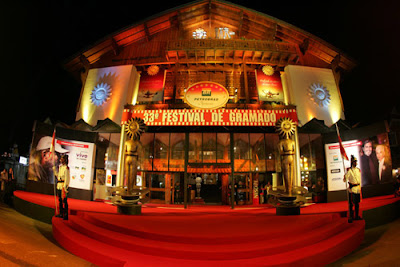What is the demand for Bollywood or other regional Indian content in Brazil?
Brazil receives its first-ever Bollywood movie pageant from the snow-clad mountains of Switzerland and the golden seashores of Mauritius, Bollywood’s made its way to the tropical Brazil. After ‘Dhoom 2’, the first-ever Indian film to be shot in Brazil, the united states now receives its very first ever ‘Bollywood and Indian Film Festival’.
 |
| Cover Image of Brazilian Cinema |
Know more About Brazilian Cinema
Many of India’s largest Bollywood films like ‘Dhoom 2’, ‘DDLJ’ and ‘The Terrorist’ will be screened in São Paulo at some stage in the movie competition to be held from March 6 to 11.
“Most Brazilians be aware of very little about Bollywood or India. This is in part due to the reality that there are very few Indians in Brazil or somewhere else in Latin America,” says Ram Prasad Devineni, the co-organiser of the pageant and additionally the founder of the first impartial movie college in Brazil.
“Also, its solely in the closing few years that Indians have been uncovered to Brazil with films like ‘City of God’, ‘Central Station’ and of course, ‘Dhoom 2’,” he adds. A mutual tie-up with Yashraj motion pictures has felicitated the showcasing of these movies.
“Brazilians be aware of that Bollywood is a massive have an effect on on the Indian masses. We can simply comprehend every different via films,” provides in Roberto Paranhos do Rio Branco, President of the Indo-Brazilian Chamber of Commerce
What is the demand for Bollywood or other regional Indian content in Brazil?
 |
| Image of What is the demand for Bollywood or other regional Indian content in Brazil |
No, in accordance to some Brazilians.
Most Brazilians by no means noticed a bollywood film and dont even comprehend it exists.
The very few bollywood movies accessible in Netflix have excellent response and Brazilians become aware of with many cultural aspects.
Before Netflix Brazilians had zero contact with bollywood. Films don't seem to be launched in video or TV, the absolute majority of Brazilians in no way noticed a bollywood movie in their.
What is the Movie culture in Brazil
Brazilian cinema was once brought early in the twentieth century however took some time to consolidate itself as a famous structure of entertainment. The movie enterprise of Brazil has long gone via durations of ups and downs, a reflection of its dependency on country funding and incentives.
Since the 1970s, the volume of movie theaters has declined heavily. During the 1990s, it grew to be frequent for small theaters to shut whilst multiplex theaters, which are generally determined in buying centers, received market share. In the ultimate decades,
the accessibility of televisions and computer systems bought at decrease expenditures blended with success in making telenovelas of excessive manufacturing excellent made cinema much less eye-catching to decrease profits audiences. In addition, ticket expenditures accelerated extra than tenfold in a span of twenty years.
In the early Nineteen Nineties Brazilian movie manufacturing suffered as a end result of the president Fernando Collor's laissez-faire policy; the region had depended on country sponsorship and protection. However, with the retomada Brazilian movie regained speed,
although now not to the equal extent it had viewed before. A great make bigger in target audience used to be recorded, however, from 2000 to 2002, with 7 million viewers, to 2003, when 22 million viewers got here to theaters to watch countrywide films.
Because these videos have been made feasible thanks to incentive legal guidelines brought in the Nineteen Nineties and that the wide variety of viewers drawn in from 12 months to 12 months can fluctuate significantly,
it is regularly wondered whether or not movie manufacturing has in truth reached a positive quantity of steadiness and whether or not or no longer it may want to in the future succumb to any governmental whims.
Incentive legal guidelines enable Brazilian videos to get hold of funding from agencies that, by using appearing as sponsors, are allowed tax deductions.
A frequent criticism is that, via this system, although motion pictures are no longer at once managed via state, they are, nevertheless, difficulty to the approval of entrepreneurs who are logically cautious as to which content material they desire to accomplice their brands.
Even with funding, there are nonetheless areas that require some battle from filmmakers, such as distribution, tv participation and DVD release.
At the give up of 2021, there have been round 3.2 thousand film theater monitors in Brazil, down from over 3.5 thousand a yr until now – an annual reduce of 9.3 percent. Meanwhile, the variety of film tickets bought in Brazil improved by means of 25 percentage between 2020 and 2021
A Brief History of Brazilian Cinema
Share this
 |
| Logo image of Brazilian Cinema |
Cinema has constantly been very popular in Brazil. By the 1930s, even the smallest towns in the northeastern interior had their own modest film palaces screening Hollywood flicks. In Rio, Praça Floriano became known as Cinelândia after the elegant downtown square used to be lined with sumptuous art deco movie palaces.
Rio was additionally the birthplace of the Brazilian film industry. In 1930, Cinédia studios began churning out a series of popular romances and burlesque musical comedies regarded as chanchadas, some of which satirized Hollywood fare. A few of these films featured a very young Carmen Miranda, then at the height of her fame as a recording star.
In the Nineteen Fifties and ’60s, dreaming of a cinema novo (new cinema) and inspired by Italian neorealism directors such as Nelson Pereira dos Santos, Ruy Guerra, Anselmo Duarte, and Glauber Rocha took to making low-budget films, many shot on vicinity in the arid Sertão, which highlighted the stark realities of the Brazilian Northeast in expressive black-and-white imagery. If not wildly popular at home, these films were a hit with worldwide critics.
In 1964, the beginning of the military dictatorship caused cinema novo to experience a surprising demise. Government hard-liners censored any criticism of Brazil and forced many directors into exile. Instead, in 1969 the government created Embrafilme, a state-run production business enterprise whose goal was to develop Brazilian filmmaking.
Although censorship, bureaucracy, and favoritism severely limited creative expression, Embrafilme did provide enough capital to maintain a small industry that funded the manufacturing of important films by major directors, such as Bruno Barreto’s Dona Flor e Seus Dois Maridos (Dona Flor and Her Two Husbands, 1976) and Cacá Diegues’s Bye Bye Brasil (1979).
The cease of Brazil’s military dictatorship also meant the end of Embrafilme and a state-subsidized movie industry. By the early 1990s only 3–4 Brazilian films were being launched each year. Fortunately, things improved with the introduction of new incentive laws whereby personal companies that invested in film productions would receive tax breaks.
Eager to see their lives depicted onscreen, Brazilians flocked to the cinema in record numbers, notwithstanding the fact that, since the 1970s, more than two-thirds of movie theaters had been closed down, regularly converted into evangelical churches.
Not only did the number of films produced regularly grow, but the quality was on par with the best of world cinema and was once recognized as such by foreign critics,
who showered awards on productions such as the Oscar-winning Central do Brasil (Central Station), directed by Walter Salles, and Fernando Meirelles’s Cidade de Deus (City of God, 2002), which took each Brazil and the world by storm with its brilliantly acted story of survival amid the gang warfare typical of a Carioca favela.


Post a Comment